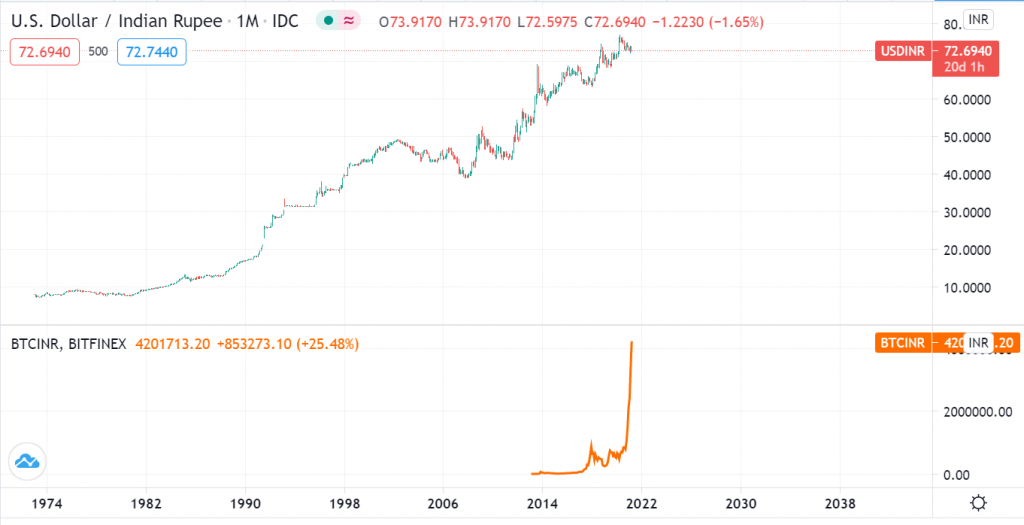Table of Contents
The Indian crypto community has grown exponentially ever since the Supreme Court lifted the banking ban on digital currencies and the ongoing Bitcoin bull run. The gap between 1 BTC to INR continues to increase in value.
In the process of educating ourselves about Bitcoin and other cryptocurrencies, we have all asked how the Indian rupee (a fiat currency) is different from Bitcoins. To understand this, one needs to understand what Bitcoin is and what it brings to the table.
What is Bitcoin?
A Bitcoin is a digital currency that is not issued by any government organization or a private institution. It is backed by powerful technology known as the “blockchain,” which makes the process trustless and prevents a single party from taking control over the process. Relative to fiat, Bitcoins provide a more secure, privacy-oriented, and cheaper way of transaction.
The markets decide the value of the Indian rupee, Bitcoin, or any other asset. The constant rise of Bitcoin price in India over the years shows strong adoption trends of Bitcoins and other cryptocurrencies.
Get WazirX News First
INR vs. BTC – a comparison
INR vs. BTC: Governance
The biggest difference between the Indian rupee and Bitcoin is their governance. INR is issued by the Reserved Bank of India (RBI), India’s central bank and regulatory body. Like other fiat currencies, INR is centralized, and the supply could be changed according to the market demands.
On the other hand, Bitcoin is governed by the community, i.e., every decision regarding the blockchain and network will be taken by the miners. The voting process in the community follows the rule of 1 GPU: 1 vote. The supply of Bitcoin is predetermined by the algorithm, and so is the number of coins.
INR vs. BTC: usability
Billions of Indians use the Indian rupee for multiple decades; like other fiat currencies, INR is mostly used in cash for day-to-day monetary needs. People can also transfer money from bank account to bank account via IMPS, NEFT, UPI, or by debit or credit cards. The cross-border transaction, where INR is converted to any other fiat, can be proved to be very costly and hence not a good option.
Bitcoin, on the other hand, is a cheaper and dependable alternative for cross-border transactions. But the algorithm of Bitcoins restricts it for commercial purposes only; the transaction speed of Bitcoins is way lower than fiat. For instance, a MasterCard can carry out thousands of transactions per second, but Bitcoin can only carry out seven transactions per second, and if the network is busy, the price could shoot up. This leaves Bitcoin room to improve usability in day-to-day life.
INR vs. BTC: How are new currencies made?
In the case of INR, as mentioned above, RBI mints new currencies. The supply is variable according to the economic conditions of India.
Bitcoin’s transactions are supported by the community, the validators of Bitcoin transactions are known as miners, and they have to solve complex mathematical problems with the help of the computation power of their hardware. In return for their computation efforts, the algorithm rewards the miners with new Bitcoins, thus adding new Bitcoins to the supply. To further increase the demand, the supply of Bitcoin is fixed to 21 million. This process determines the Bitcoin price in INR, or any other currency for that matter.
INR vs. BTC: volatility
Since the whole country uses INR, it is important that it not be volatile. Due to this stable nature, you will find pairs like BTC to INR on Indian crypto exchanges. Traders can still trade INR on forex markets but less profitable than Bitcoin and other cryptocurrencies.
Bitcoin is volatile in nature, so volatile that it sometimes makes moves worth lakhs of rupees in a matter of hours. But this volatile nature of Bitcoin helped it increase its value from less than INR 50 to more than INR 40 Lakhs.
INR vs. BTC: currency model
The value of INR depends on inflation, forex demand, economic conditions, and many other factors. Even though the RBI can’t directly influence INR’s forex value, it can alter the supply by minting more or less amount, potentially influencing the buying and selling power.
Bitcoin comes into the category of the deflationary model of cryptocurrencies; this is because the mining reward is halved after every 210,000 blocks are mining. Also, the supply of Bitcoins has an upper market cap of 21 million. Due to these demand and supply rules, the price of BTC to INR is always on the rise.
INR vs. BTC: investment

INR and other fiats are generally safer than cryptocurrencies and require skills for good returns. Forex markets are generally not volatile and are made for scalping. They are certainly not profitable as the BTC markets.
Even though cryptocurrencies are volatile, they can bring you significant returns if you play your cards right. The above chart shows the exponential growth of BTC over the years in the monthly time frame.
Want to invest in Bitcoins from India? WazirX has got you covered with hundreds of cryptocurrencies from BTC to INR pairs. Sign up on WazirX right now.
Further Reading:
How to trade in cryptocurrency in INR?
6 Things to Consider Before Investing in Bitcoin
4 Things to Consider Before Investing in Cryptocurrencies
Frequently Asked Questions
How To Create Bitcoin Account?
Firstly, Go to the WazirX website and sign up. Then, a verification mail will be sent to you. The link sent via verification mail would be available only for a few seconds so make sure you click on the link sent to you as soon as possible, and it will verify your email address successfully. The next step is to set up security, so select the most suitable option for you. After you have set up the security, you will get a choice to either proceed further with or without completing the KYC procedure. After that, you will be directed to the Funds and Transfer page, where you could start depositing Bitcoins to your wallet. You can also deposit INR and then use it to buy Bitcoin for your WazirX Bitcoin wallet.
How To Convert Bitcoin To Cash?
There are many ways of converting Bitcoin to cash, such as crypto exchanges, Bitcoin ATMs, Bitcoin Debit Cards, Peer to Peer Transactions. You can use cryptocurrency exchanges such as WazirX for this. Unlike typical ATMs, which allow you to withdraw money from your bank account, a Bitcoin ATM is a physical location where you may buy and sell Bitcoins using fiat currency. Several websites provide the option of selling Bitcoin in return for a prepaid debit card that may be used just like a standard debit card. You can sell Bitcoin for cash through a peer-to-peer platform in a faster and more anonymous manner.
How Does Bitcoin Work?
The blockchain, a distributed digital ledger, is what Bitcoin is based on. As the name suggests, blockchain is a linked database made up of blocks that store information about each transaction, such as the date and time, total amount, buyer and seller, and a unique identifier for each exchange. Entries are linked in chronological order to form a digital blockchain. Entries are linked in chronological order to form a digital blockchain. Blockchain is decentralized, which means any central authority does not control it.
How Many Bitcoins Are There?
There are 18,730,931.25 Bitcoins in circulation as of June 2021. The total number of Bitcoins that would ever be there is just 21 million. On average, 144 blocks are mined every day, with 6.25 Bitcoins per block. The average number of new Bitcoins mined every day is 900, calculated by multiplying 144 by 6.25.
Who Created Bitcoin?
Bitcoin is the first application of the concept of "cryptocurrency," first articulated in 1998 on the cypherpunks mailing list by Wei Dai, who proposed a new form of money that relies on cryptography rather than a central authority to manage its creation and transactions. Satoshi Nakamoto published the initial Bitcoin specification and proof of concept on the cryptography mailing list in 2009. Satoshi exited the project in late 2010, with little information about himself available. Since then, the community has evolved, with numerous people working on Bitcoin. Satoshi's anonymity has sparked unfounded fears, many of which may be traced back to a misunderstanding of Bitcoin's open-source nature.
Is Bitcoin Cash A Good Investment?
Bitcoin Cash is a hard fork of Bitcoin formed in 2017 to address Bitcoin's scalability and challenges. Bitcoin Cash seeks to make global transactions faster, cheaper, and more secure. Bitcoin Cash is now accepted by thousands of online and offline businesses all over the world. Studied correctly, Bitcoin Cash may be an investment worthy of consideration.
What Are The Chances Of Bitcoin Crashing?
Two Yale University economists (Yukun Liu and Aleh Tsyvinski) produced research titled "Risks and Returns of Cryptocurrency" in 2018. They looked at the possibility of Bitcoin crashing to zero in a single day. The authors discovered that the chances of an undefined tragedy crashing Bitcoin to zero ranged from 0 percent to 1.3 percent and was around 0.4 percent at the time of publishing, using Bitcoin's history returns to determine its risk-neutral disaster probability. Others claim that because Bitcoin has no intrinsic value, it will inevitably crash to zero. On the other hand, Bitcoin advocates argue that the currency is backed by customer confidence and mathematics.
Is Bitcoin Legal In India?
In India, Bitcoin is not illegal. Because of cryptocurrency's rapid evolution, policymakers and regulators seemed to have recognized the chance to accept the new technology early. From the infamous 'RBI ban' in 2018 to reports of an impending bill banning cryptos in 2021 that has yet to develop, India has seen its fair share of ups and downs when it comes to Bitcoin regulation. Last year, the Supreme Court Of India approved the use of Bitcoin throughout the country. According to the Supreme Court, the existence of Bitcoin or any other cryptocurrency is unregulated but not unlawful.
How To Invest In Bitcoin?
Bitcoin may be invested in two ways: through mining or exchanges. Bitcoin mining is carried out by high-powered computers that solve challenging computational arithmetic problems that are too difficult to complete by hand and complex enough to tax even the most powerful computers. WazirX, a Bitcoin exchange, is another alternative.
What Type Of Currency Is Bitcoin?
Bitcoin is a type of digital currency or cryptocurrency. In January 2009, Bitcoin was established. It's based on Satoshi Nakamoto's ideas, which he laid out in a whitepaper. The name of the individual or people who invented the technology remains unknown.




















